Knife sharpening is an essential skill for any cook or chef, ensuring safety and efficiency in the kitchen. Learn how to maintain and sharpen your blades effectively.
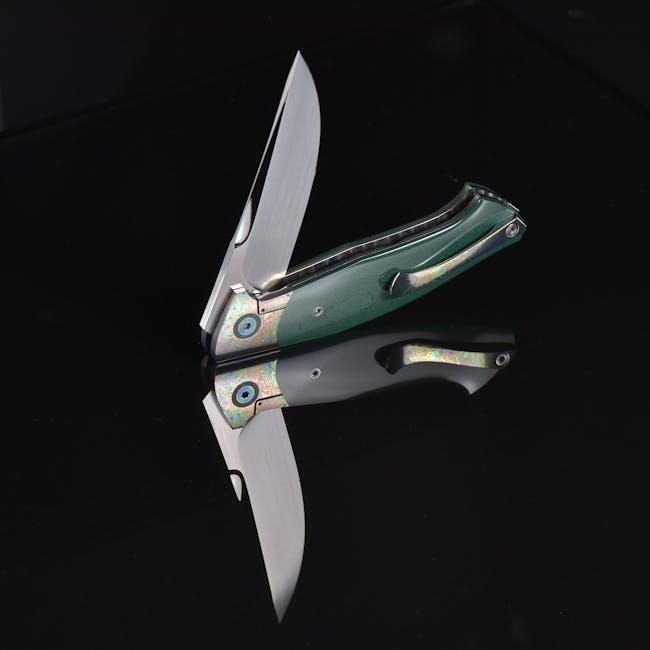
The Importance of Sharp Knives
Sharp knives are essential for safety, precision, and efficiency in the kitchen. A dull knife requires more force, increasing the risk of accidents. Sharp blades cut cleanly, reducing the likelihood of slipping and injuries. They also make food preparation faster and more effortless, ensuring better results. Additionally, sharp knives are easier to control, allowing for precise cuts and maintaining the quality of ingredients. Regular sharpening extends the life of your knives and prevents premature wear. A sharp knife is not just a tool; it’s a key to safer, more enjoyable cooking experiences.
Basic Principles of Knife Sharpening
Knife sharpening revolves around creating and maintaining a sharp edge through consistent angle control and proper abrasive use. The process involves removing metal to form a precise edge, typically using tools like stones or steels. Angle control is crucial; most knives require a 20-degree angle for sharpening. Using the correct grit ensures effectiveness—coarse grits for repairing damaged edges and fine grits for polishing. Regular maintenance, including honing, preserves sharpness. Sharpening requires patience and practice to master, but understanding these principles lays the foundation for achieving professional results. Consistency and attention to detail are key to maintaining a razor-sharp edge.

Types of Knife Sharpeners
Knife sharpeners come in various forms, including manual, electric, and stone-based options, each designed for precision, convenience, and durability. Choose one that suits your skill level and needs.
Honing Steels
Honing steels, also known as sharpening steels, are essential for maintaining knife edges. They align the blade’s microteeth, restoring sharpness without removing metal. Ideal for regular maintenance, they are easy to use and portable. A fine-grit ceramic or steel rod is recommended for precise results. Honing steels are not for sharpening dull knives but for refining already sharp edges. Use them before and after cooking to ensure peak performance. Proper technique involves holding the knife at the correct angle and drawing it along the steel. This tool is perfect for quick touch-ups, keeping knives safe and effective for everyday use. Regular honing extends the life of your blades and enhances cutting precision.
Sharpening Stones
Sharpening stones, including water stones and oil stones, are traditional tools for sharpening knives. They offer precise control over the sharpening process, allowing for customized edge refinement. Water stones are popular for their effectiveness and ease of use, while oil stones are known for durability. Stones come in various grits, from coarse for repairing damaged edges to fine for polishing. Regular use of sharpening stones ensures a razor-sharp edge, making them ideal for both professionals and home cooks. They require patience and practice but deliver exceptional results, extending the life of your knives and improving their performance in the kitchen.
Electric Knife Sharpeners
Electric knife sharpeners are convenient and user-friendly tools designed for quick and efficient sharpening. They typically feature multiple stages, from coarse grinding to fine polishing, ensuring a precise edge. These sharpeners are ideal for those who value speed and consistency, as they automate the sharpening process. They are suitable for various knife types, including straight-edge and serrated blades. While they may remove more metal than manual methods, they are reliable for maintaining sharpness. Electric sharpeners are popular among home cooks and professionals alike, offering a hassle-free solution to keep knives in optimal condition without requiring extensive sharpening skills or time.
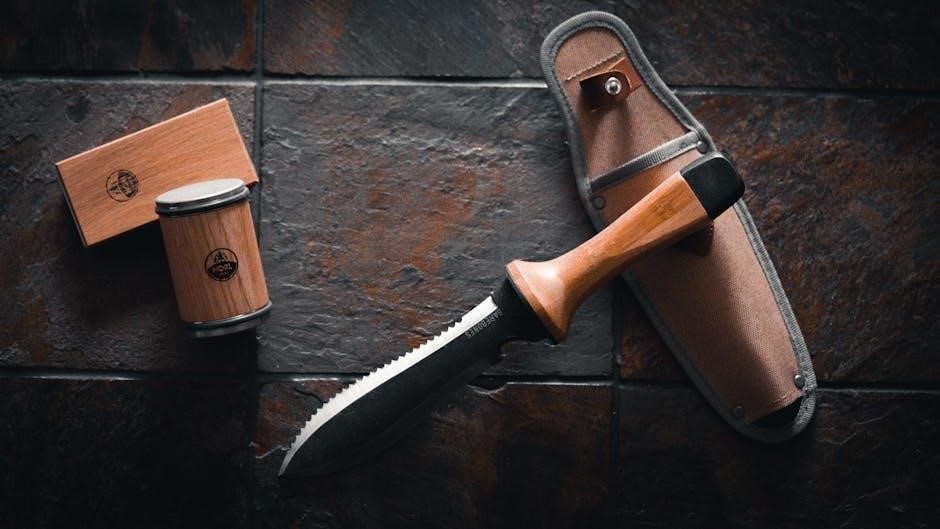
Pull-Through Sharpeners
Pull-through sharpeners are simple, portable tools designed for quick touch-ups and light sharpening. They feature carbide blades or ceramic edges that sharpen the knife as it is pulled through the device. These sharpeners are ideal for maintaining a sharp edge between more thorough sharpening sessions. They are easy to use and require minimal skill, making them a great option for home cooks. However, they may not be as effective for heavily dulled knives. Pull-through sharpeners are affordable, compact, and convenient for everyday use, ensuring your knife stays sharp with minimal effort. They are particularly useful for outdoor activities or quick kitchen tasks.

Whetstones
Whetstones are traditional sharpening tools offering precision and control. They consist of a rectangular stone with coarse and fine grit surfaces. Coarse grit removes metal quickly, while fine grit polishes the edge. Whetstones are versatile, suitable for various knife types and edge repairs. They require water or oil for effective sharpening, preventing clogging. With practice, they produce sharp, professional results. Whetstones are durable and cost-effective, making them a favorite among experts. Regular use enhances sharpening skills, ensuring optimal blade performance. They are ideal for detailed work and maintaining high-quality knives, offering a timeless method for achieving razor-sharp edges with patience and technique.
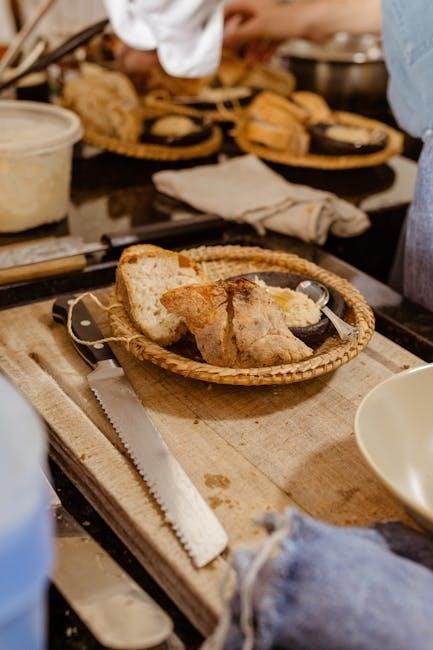
How to Choose the Right Sharpener for Your Needs
Selecting the right sharpener depends on your skill level, knife type, and budget. Consider ease of use, durability, and specific features for optimal sharpening results.
Consider Your Skill Level
Your skill level is crucial when choosing a sharpener. Beginners may find electric or pull-through sharpeners user-friendly, requiring minimal technique. Advanced users might prefer sharpening stones or honing steels, offering precise control. Electric sharpeners are ideal for those seeking convenience and consistency, while manual methods suit enthusiasts looking to refine their skills. Novice sharpeners should avoid complex systems that require extensive practice to master. By matching your expertise with the right tool, you ensure effective sharpening and a better overall experience. This approach helps prevent common mistakes and enhances the sharpening process for all skill levels. Proper alignment and angle control are key.
Types of Knives You Own
The type of knife you own plays a significant role in choosing the right sharpener. Straight-edge knives, such as chef’s knives or utility knives, work well with honing steels or sharpening stones. Serrated knives require specialized sharpeners or diamond stones to maintain their unique edge. Pocket knives and hunting knives may benefit from portable pull-through sharpeners for convenience. High-carbon steel knives respond best to water or oil stones, while ceramic knives need diamond or ceramic sharpeners. Consider the frequency of use and the knife’s material to select a sharpener that maintains its edge effectively. Matching the sharpener to your knife ensures optimal performance and longevity. Proper care extends the life of your blades.
Budget and Durability
Your budget and the sharpener’s durability are crucial factors to consider. Basic sharpeners, like pull-through models, are affordable and suitable for occasional use. For those willing to invest, electric sharpeners offer convenience and precision but are more expensive. Sharpening stones, while durable, require a higher initial investment and practice to master. Ceramic rods are long-lasting and low-maintenance, fitting mid-range budgets. Assessing how often you sharpen and the lifespan of the tool helps balance cost and quality. Durable options may cost more upfront but provide long-term savings and better results. Consider your usage frequency and long-term needs when selecting a sharpener to ensure value for money. Proper maintenance can extend the life of your chosen sharpener. Always weigh cost against durability and performance.
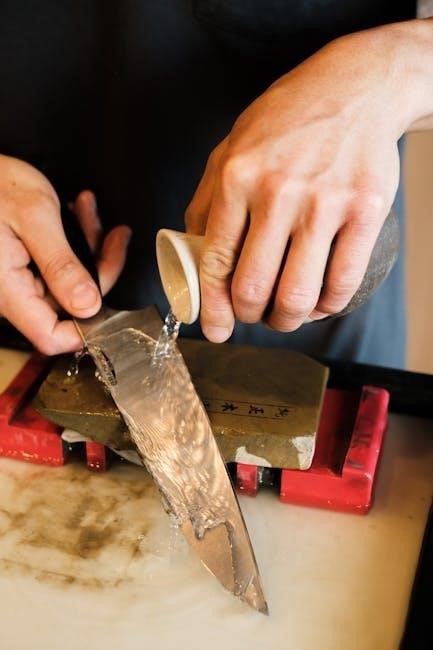
A Step-by-Step Guide to Sharpening a Knife
Sharpening a knife involves preparing tools, maintaining the correct angle, and testing sharpness. Follow these steps to achieve a precise and sharp edge every time.
Preparing the Knife and Sharpener
Before sharpening, inspect the knife for any debris or damage. Ensure the blade is clean and dry. Choose the appropriate sharpener for your knife type, whether it’s a honing steel, sharpening stone, or electric sharpener. Position the sharpener on a stable surface. For manual sharpeners, soak the stone in water for 10-15 minutes if required. Align the knife at the correct angle, typically between 15° to 20° for straight-edge knives. Always sharpen away from your body for safety. Proper preparation ensures a smooth and effective sharpening process, preventing accidents and achieving optimal results. Consistency is key to maintaining a sharp edge.
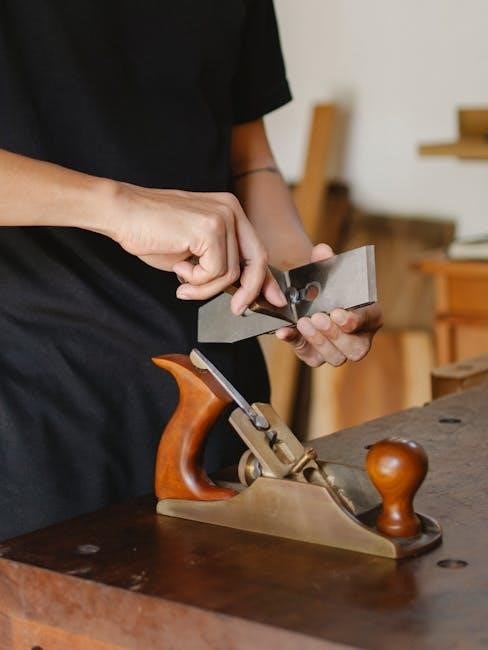
Sharpening at the Correct Angle
Sharpening at the correct angle is crucial for achieving a sharp, durable edge. Most straight-edge knives require a 15° to 20° angle, while serrated knives may need a slightly different approach. To maintain consistency, place the knife heel (the back of the blade) on the sharpener and gently draw it across, keeping the angle steady. For manual sharpeners, use a guide or marker to help maintain the angle. Electric sharpeners often have preset angles, simplifying the process. Always sharpen in one direction, from heel to tip, to avoid uneven edges. Practice is key to mastering the angle, ensuring optimal results and extending the knife’s lifespan.
Testing the Sharpness
Testing the sharpness of your knife is essential to ensure it’s ready for use; A sharp blade should effortlessly slice through materials like paper or a ripe tomato. One common method is the paper test, where a sharp knife glides through a sheet of paper without tearing it. Another technique is the tomato test, where the knife should cleanly cut through the skin without crushing the fruit. Visually inspect the edge for evenness and light reflection, as a sharp knife will have a polished, reflective edge. Always test on a soft material first to avoid damaging the blade. Regular testing ensures optimal performance and safety in the kitchen or workshop.
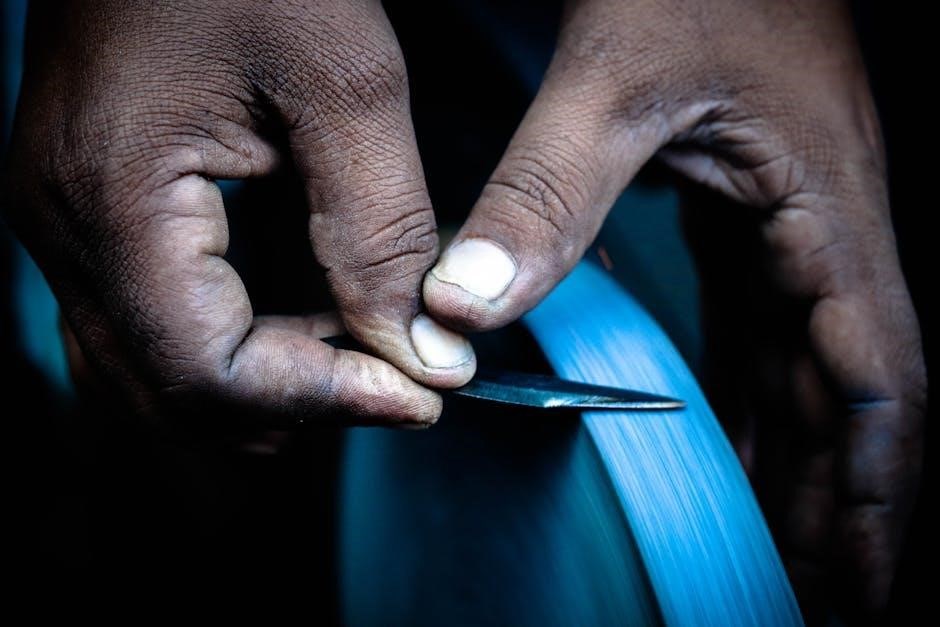
Maintenance and Care
Proper maintenance ensures longevity. Clean and store sharpeners correctly, avoid damaging the tools, and use techniques that preserve their effectiveness. Regular care enhances sharpening results.
How to Maintain Your Knife Sharpener
Regularly cleaning your knife sharpener is crucial to maintain its effectiveness. For stone sharpeners, rinse with water or oil, depending on the type. Electric sharpeners require wiping down with a damp cloth to remove metal particles. Honing steels should be cleaned with a soft cloth to prevent residue buildup. Store sharpeners in a dry place to avoid rust or damage. Proper maintenance ensures consistent results and extends the tool’s lifespan. Neglecting care can lead to decreased performance, making sharpening less efficient. Always follow the manufacturer’s guidelines for specific care instructions.
How Often to Sharpen Your Kitchen Knife
The frequency of sharpening your kitchen knife depends on usage. If used daily, especially for cutting tough materials, sharpening once a week is recommended. For less frequent use, every 2-3 months suffices. Honing with a steel can be done weekly to maintain edge sharpness. Signs of dullness, like difficulty cutting or tearing food, indicate it’s time to sharpen. Regular maintenance prevents the blade from becoming too worn, making sharpening more challenging. Consistent care ensures optimal performance and longevity of your knife, keeping it safe and efficient for cooking tasks.
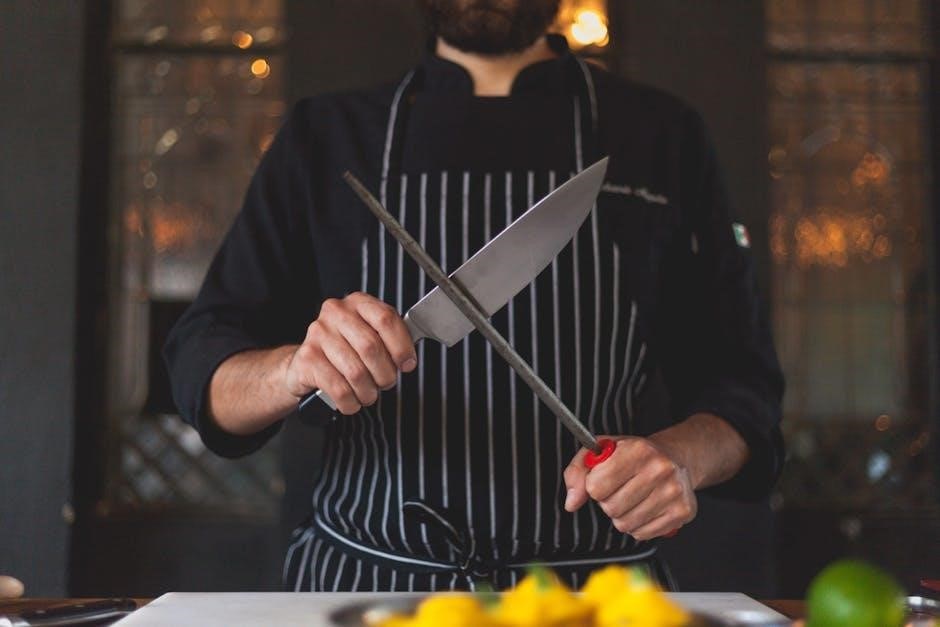
Common Mistakes to Avoid
Avoid sharpening at the wrong angle and using the wrong grit. Applying too much pressure can damage the blade. Regular honing prevents dullness and extends knife life.
Sharpening at the Wrong Angle
Sharpening at the wrong angle is a common mistake that can lead to poor results. Most knives require a specific angle, typically between 20° and 30°, depending on the type of knife. Using too low an angle can result in a dull edge, while too high an angle may leave the knife uneven. To avoid this, use angle guides or practice sharpening on an old knife to develop muscle memory. Always check the edge frequently and adjust as needed. Consistency is key to achieving a sharp, even blade. Remember, the angle is crucial for both sharpening and honing, so take your time to get it right.
Using the Wrong Grit
Using the wrong grit is a common mistake that can hinder the sharpening process. Coarse grits (e.g., 600-800) are for shaping and repairing edges, while finer grits (e.g., 4000-6000) polish and refine the blade. Using too fine a grit too early can make sharpening ineffective, as it won’t remove enough metal. Conversely, using only coarse grits may leave the edge rough and prone to dulling quickly. Always start with a coarse grit to establish the edge, then progress to finer grits for honing. Proper grit progression ensures a sharp, durable edge. Avoid skipping grits, as this can damage the knife or leave it improperly sharpened.
Mastery of knife sharpening is an essential skill, requiring consistent practice and the right tools to achieve optimal results for a safer, more efficient cooking experience.
Knife sharpening is a crucial skill that enhances safety and efficiency in the kitchen. Sharp knives are safer, as they require less force and reduce the risk of accidents. Regular maintenance, including honing and sharpening, ensures blades remain effective. Various sharpening tools, such as honing steels, sharpening stones, and electric sharpeners, cater to different skill levels and knife types. Choosing the right sharpener depends on personal preference, budget, and the type of knives you own. Techniques like sharpening at the correct angle and using proper grit are vital for achieving a razor-sharp edge. Avoid common mistakes, such as sharpening at the wrong angle or using the wrong grit, to maintain your knife’s integrity. Consistent practice and patience are key to mastering the art of knife sharpening.
Final Tips for Success
Always choose the right sharpener for your knife type and skill level. Practice regularly to refine your technique and maintain consistent results. Sharpen at the correct angle to avoid damaging the blade. Use the appropriate grit for your knife’s condition, starting with coarser grits for dull blades. Regular honing between sharpening sessions keeps knives in top shape. Store your sharpening tools and knives properly to ensure longevity. Stay patient and persistent, as mastering knife sharpening takes time. Sharpen away from your body for safety. By following these tips, you’ll achieve sharp, reliable blades that elevate your cooking and prep work.